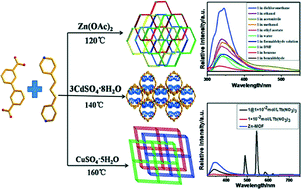Metal(ii)–organic frameworks with 3,3′-diphenyldicarboxylate and 1,3-bis(4-pyridyl)propane: preparation, crystal structures and luminescence†
Abstract
Mixing transition metal(II) salts with 3,3′-diphenyldicarboxylic acid (3,3′-H2dpdc) and 1,3-bis(4-pyridyl)propane (bpp) led to the complexes [M(3,3′-dpdc)bpp] (M = Zn 1, Cd 2) and [Cu2(3,3′-dpdc)2(bpp)] (3). These complexes were characterized by single-crystal X-ray diffraction. 1 possesses a four-fold interpenetrating 3D diamondoid framework consisting of Zn-3,3′-dpdc and Zn-3,3′-dpdc-bpp helices and has a 66 topology net with 4-c tetrahedral Zn(II) nodes. 2 exhibits a 3D framework consisting of Cd-3,3′-dpdc-bpp two/four-stranded helices and has a 6-c {36·412·54·66} topology with binuclear blocks. 3 has a three-fold interpenetrating 3D framework with a 6-c {312·428·55} topology based on binuclear blocks. Cu-3,3′-dpdc and Cu-bpp-3,3′-dpdc helices are formed. The metal centers play a crucial role in the system structure direction. The luminescence properties of these compounds were investigated. The results show that 1 can be used as a fluorescent probe to detect benzaldehyde and sensitize Tb(III) luminescence. Notably, addition of Tb(III) into the Zn-MOF (1) greatly enhanced its ability to detect benzaldehyde.


 Please wait while we load your content...
Please wait while we load your content...